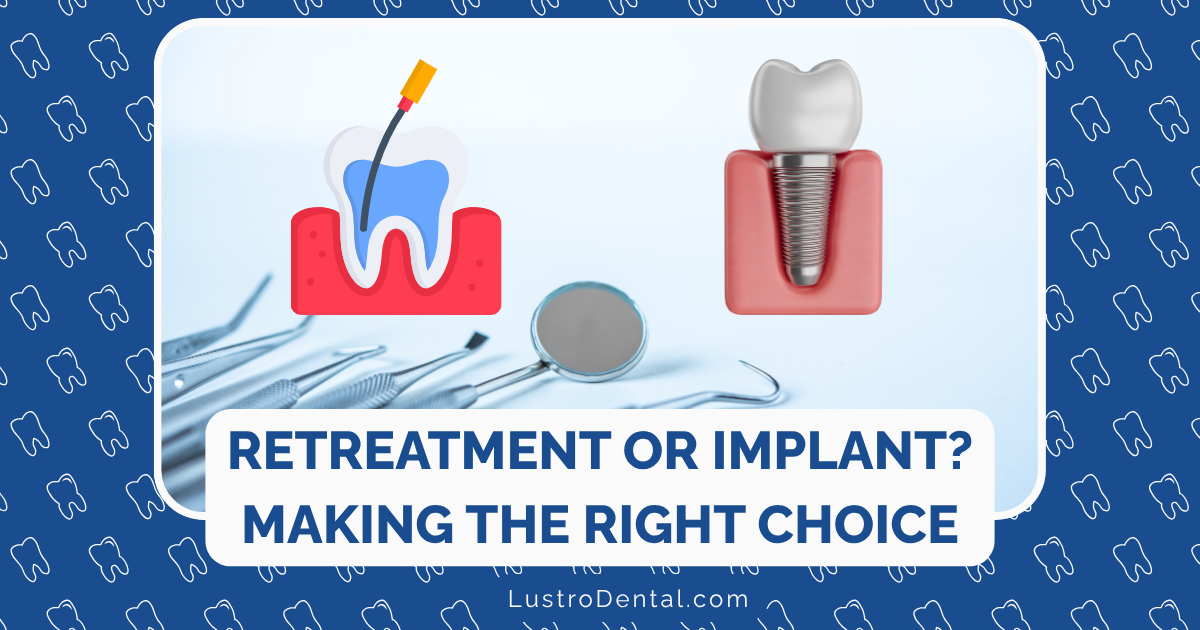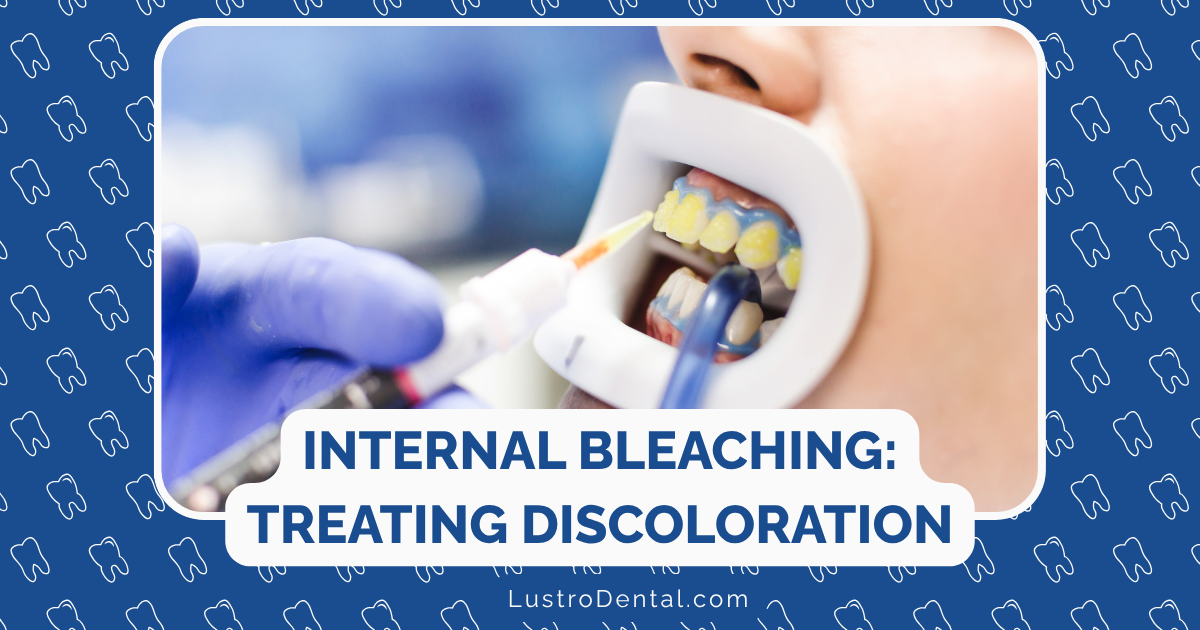Weighing Your Options: Retreatment vs. Extraction and Implant

When a root canal treatment fails, patients often find themselves at a crossroads, facing a significant decision: attempt to save the tooth through endodontic retreatment, or extract it and replace it with an implant? This choice can feel overwhelming, especially when you’re dealing with discomfort and uncertainty about the future of your oral health.
As a dental health advocate who has guided many patients through this decision, I understand the complexity of this choice. Both options have their merits, and the “right” decision varies based on numerous factors unique to each situation. In this comprehensive guide, I’ll walk you through the key considerations to help you make an informed choice that aligns with your oral health needs, lifestyle, and personal preferences.
Understanding Your Options
Before diving into comparisons, let’s clearly define what each treatment path entails:
Endodontic Retreatment
Endodontic retreatment involves reopening the tooth, removing the existing root canal filling material, addressing the issues that caused the initial failure (such as missed canals, persistent infection, or inadequate cleaning), and then placing new filling material before restoring the tooth.
Dr. Sarah Johnson, endodontist at Midtown Endodontist NYC, explains: “Retreatment gives your natural tooth a second chance. With advanced techniques and technology like dental operating microscopes, we can often address issues that weren’t detectable or treatable during the initial procedure.”
Extraction and Implant
This approach involves removing the problematic tooth and replacing it with a dental implant—a titanium post surgically placed in the jawbone that serves as an artificial tooth root. After a healing period (typically 3-6 months), a crown is attached to the implant to restore function and appearance.
Success Rates: How the Options Compare
When evaluating treatment options, success rates are a primary consideration. Here’s what current research tells us:
Retreatment Success Rates
According to a comprehensive analysis published in the Journal of Endodontics:
- Nonsurgical retreatment has a success rate of approximately 78.2%
- Success rates for retreatment range from 59.5% to 95%, depending on case complexity
- Factors influencing success include the reason for initial failure, tooth type, and presence of periapical lesions
A 2024 study in Dentistry Today reported even more encouraging figures:
- Complete healing rates for nonsurgical retreatment range from 74% to 98%
- Treatments provided by endodontic specialists have a statistically higher success rate (98.1%) compared to general dentists (89.7%)
Implant Success Rates
The same Journal of Endodontics analysis reported:
- Dental implants have an overall success rate of 90.9%
- Success rates for implants range from 74.6% to 99%
- Factors affecting implant success include bone quality, smoking status, and presence of periodontal disease
It’s important to note that success criteria differ between the two treatments. For retreatment, success typically means absence of symptoms and radiographic evidence of healing. For implants, success means osseointegration (fusion with the bone) and functional restoration.
Dr. Michael Chen, periodontist, notes: “Both treatments have excellent outcomes when performed in appropriate cases by skilled clinicians. The decision shouldn’t be based solely on general success rates but rather on the specific factors of your case.”
Cost Comparison: Financial Considerations
Treatment costs can vary significantly based on location, provider, and specific case details, but general comparisons can help frame the financial aspect of your decision:
Retreatment Costs
- Root canal retreatment: $700-$1,500 per tooth
- Crown (if needed): $800-$1,500
- Total estimated cost: $1,500-$3,000
Extraction and Implant Costs
- Tooth extraction: $150-$650
- Implant placement: $1,500-$3,000
- Abutment and crown: $1,500-$3,000
- Possible bone grafting (if needed): $300-$800
- Total estimated cost: $3,450-$7,450
According to Healthline, the total cost for extraction and implant can range from $4,000 to $10,500, making it significantly more expensive than retreatment in most cases.
A 2023 cost-effectiveness analysis published in the Journal of Endodontics found that:
- Endodontic retreatment is more cost-effective than extraction and implant
- Even when accounting for potential future treatments, retreatment remains the more economical option in most scenarios
Insurance Considerations
Dental insurance typically provides better coverage for endodontic procedures than for implants:
- Many plans cover 50-80% of retreatment costs
- Implant coverage is often limited or excluded entirely
- Some medical insurance plans may partially cover implants in certain situations (such as accidents)
Always check with your insurance provider about specific coverage details before making your decision.
Timeline and Recovery Comparison
The treatment timeline and recovery experience differ substantially between these options:
Retreatment Timeline
- Treatment duration: Typically 1-3 appointments over 1-2 weeks
- Immediate recovery: 1-3 days of mild discomfort
- Return to normal function: Usually within a week
- Total time investment: 2-3 weeks from start to finish
Extraction and Implant Timeline
- Extraction and implant placement: 1-2 appointments
- Initial healing period: 1-2 weeks for soft tissue healing
- Osseointegration period: 3-6 months before crown placement
- Final restoration: 1-2 appointments for abutment and crown
- Total time investment: 4-8 months from start to finish
Dr. Lisa Wong, prosthodontist at Maple Dental Health, explains: “The implant process requires patience. While you’ll have a temporary restoration during healing, the entire process takes months to complete. Retreatment offers a much quicker resolution, which can be a significant factor for many patients.”
Key Decision Factors: When to Choose Each Option
The ideal treatment depends on numerous factors specific to your situation. Here’s a framework for evaluating which option might be best for you:
Factors Favoring Retreatment
- Restorable tooth structure: If sufficient healthy tooth structure remains to support a restoration
- Strategic tooth importance: Front teeth or teeth crucial for proper bite function
- Good periodontal health: Healthy supporting bone and gum tissue
- Preference for preserving natural teeth: Strong desire to maintain original dentition
- Time constraints: Need for faster treatment completion
- Financial limitations: Budget constraints or better insurance coverage for endodontic procedures
- Medical contraindications to surgery: Conditions that make implant surgery riskier
Factors Favoring Extraction and Implant
- Severely compromised tooth: Extensive decay, fracture, or insufficient remaining structure
- Failed previous retreatment: Multiple unsuccessful attempts to save the tooth
- Significant structural issues: Vertical root fracture or severe resorption
- Advanced periodontal disease: Significant bone loss around the tooth
- Anatomical complexities: Unusual root anatomy that complicates retreatment
- Long-term perspective: Willingness to invest more upfront for potentially longer-lasting results
- Preference for definitive solution: Desire to avoid possible future retreatment
Dr. Robert Wilson, endodontist at Dentistry Today, notes an important statistic: “Most endodontically treated teeth are rarely extracted due to endodontic reasons (less than 8.6%); they’re primarily extracted due to restorative (32.0%) or periodontal (59.4%) failures. This underscores the importance of evaluating the tooth’s overall condition, not just the endodontic status.”
Pros and Cons: A Side-by-Side Comparison
To further clarify your options, let’s examine the advantages and disadvantages of each approach:
Retreatment Pros
- Preserves natural tooth: Maintains original dentition and proprioception
- Less invasive: No surgical extraction or implantation
- Faster completion: Treatment completed in weeks rather than months
- Lower initial cost: Typically less expensive than implant treatment
- Preserves bone structure: Natural tooth root continues to stimulate jawbone
- Simpler procedure: Fewer steps and appointments than implant treatment
- Immediate results: No waiting period for osseointegration
Retreatment Cons
- Not always possible: Some teeth may be too damaged for successful retreatment
- Potential for additional treatment: May require further intervention if issues persist
- Weakened tooth structure: Multiple treatments can compromise tooth strength
- Variable long-term prognosis: Success depends on many factors
- Psychological factor: Anxiety about retreating an already failed procedure
Extraction and Implant Pros
- High success rate: Excellent long-term success in appropriate cases
- Fresh start: Eliminates existing infection and problematic tooth
- Predictable outcome: Not dependent on previous root canal condition
- Durability: Implants can last decades with proper care
- Aesthetic results: Modern implants closely mimic natural teeth
- No risk of root fracture: Implants can’t develop the vertical fractures that sometimes affect endodontically treated teeth
- Self-contained: Doesn’t affect adjacent teeth (unlike bridges)
Extraction and Implant Cons
- Higher cost: Significantly more expensive than retreatment
- Surgical procedure: More invasive, requiring bone surgery
- Longer treatment time: Months-long process from extraction to final restoration
- Bone requirements: Adequate bone volume needed (may require grafting)
- Not suitable for everyone: Medical conditions may contraindicate surgery
- Potential complications: Risk of peri-implantitis and other implant-specific issues
- Irreversible decision: Once a tooth is extracted, that decision can’t be reversed
Long-Term Considerations: Beyond the Initial Treatment
When making your decision, it’s important to consider the long-term implications:
Retreated Teeth: Long-Term Outlook
- Potential for future issues: Some retreated teeth may eventually require additional treatment
- Monitoring requirements: Regular check-ups to ensure continued health
- Restoration maintenance: Crowns may need replacement after 10-15 years
- Impact on adjacent teeth: Preserving natural teeth helps maintain overall dental arch integrity
Dental Implants: Long-Term Outlook
- Maintenance needs: Regular professional cleaning and monitoring
- Potential complications: Risk of peri-implantitis (implant gum disease), which affects 10-20% of implants within 5-10 years
- Hardware issues: Possible screw loosening, crown fracture, or other mechanical complications
- Bone preservation: Implants help maintain jawbone volume, preventing resorption
A 2023 8-year follow-up study comparing retreatment to extraction and implant found:
- 85.1% survival rate for retreated teeth
- 98.2% survival rate for implants
- Higher rate of serious complications (15%) in the retreatment group, primarily due to root fractures
- Higher incidence of minor prosthetic complications (14%) in the implant group
The Decision-Making Process: Practical Steps
If you’re facing this decision, here’s a step-by-step approach to help you arrive at the best choice for your situation:
1. Get a Comprehensive Evaluation
Seek evaluations from both an endodontist and an implant specialist (periodontist or oral surgeon). This provides balanced perspectives and ensures you understand all viable options.
2. Ask the Right Questions
During your consultations, ask:
- What is the specific reason my initial root canal failed?
- What is the likelihood of successful retreatment in my case?
- What is my bone quality and quantity for implant placement?
- What would be the total cost and timeline for each option?
- What maintenance will each option require long-term?
- What would you recommend if I were your family member?
3. Consider Your Personal Priorities
Reflect on what matters most to you:
- Is preserving your natural tooth a priority?
- How important is treatment timeline?
- What can you realistically afford?
- How do you feel about surgical procedures?
- What does your insurance cover?
4. Develop a Contingency Plan
Understand what your options would be if your chosen treatment doesn’t succeed:
- If retreatment fails, would extraction and implant still be viable?
- If an implant fails, what alternatives would remain?
Dr. James Miller, prosthodontist, advises: “The best approach is often to try the more conservative option first, if appropriate. You can always move to extraction and implant if retreatment fails, but you can’t go back once a tooth is extracted.”
Conclusion: Making Your Decision
Both endodontic retreatment and extraction with implant placement can be excellent treatment options with high success rates when performed in appropriate cases by skilled clinicians. The “right” choice depends on your specific clinical situation, personal preferences, financial considerations, and long-term goals.
Remember that this decision doesn’t have to be made alone. Your dental team should serve as partners in your decision-making process, providing the information and guidance you need to make a choice that aligns with your overall oral health objectives.
Whatever you decide, maintaining excellent oral hygiene and attending regular dental check-ups will be essential for the long-term success of either treatment. With proper care, both retreated teeth and dental implants can provide years of comfortable function and aesthetic satisfaction.
Have you faced this decision between retreatment and extraction with implant? What factors influenced your choice? Share your experience in the comments below to help others navigating this decision.







